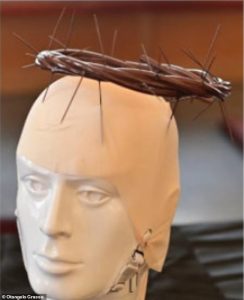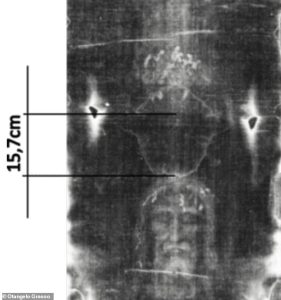Key Takeaways
- Forensic analysis of Shroud of Turin bloodstains reveals Jesus’ Crown of Thorns was likely a ring-like wreath
- Study finds concentrated wounds at hairline, temples and nape – not across entire scalp
- Research combines blood pattern analysis, historical texts and experimental reconstruction
A new forensic study claims to have solved the centuries-old mystery of what Jesus’ Crown of Thorns actually looked like. Biological systems analyst Otangelo Grasso used advanced bloodstain analysis on the Shroud of Turin to determine the crown was a circular wreath rather than a full helmet of thorns.
The Centuries-Old Debate
Scholars have long debated whether the Crown of Thorns was a simple circlet placed around Jesus’ head or a cap covering his entire scalp. The Bible describes Roman soldiers twisting thorns into a crown and placing it on Jesus’ head as mockery before his crucifixion.
Grasso’s research analyzed bloodstain distribution on the Shroud, geometric cloth gaps, and engineering complexity of different crown structures. The study found concentrated bloodstains at the brow, temples and nape, with no blood transfer at the very top of the head.
‘The absence of blood at the very top of the head is a key clue that rules out a helmet-style crown,’ the study explains.
Challenging the Helmet Theory
Supporters of the cap theory point to over 50 puncture wounds across the scalp, arguing a simple headband couldn’t cause such extensive injuries. However, Grasso’s forensic analysis shows scalp blood could reactivate after death through hair wicking, allowing transfer during burial.
‘Some droplets should still appear on the bridge unless the vertex wounds dried unusually fast or were fully contained by hair,’ Grasso explained. ‘The circlet explains the same observations with fewer auxiliary assumptions.’
Experimental Evidence
In experimental reconstructions, a circlet with inward-pointing thorns produced perimeter staining and specific puncture patterns. The helmet model would require complex lattice construction taking over two hours, while a circlet could be made with one structural join.
Historical evidence also supports the circlet theory. Early Christian texts use Greek words meaning ‘plaited wreath’ rather than cap, suggesting a parody of royal crowns.
Corroborating Evidence
The Sudarium of Oviedo, another cloth believed to have covered Jesus’ face, contains bloodstains consistent with a crucified man. Blood patterns on both relics match a narrow band of wounds from a ring-style crown.
‘Geometric analysis demonstrates circlet compatibility,’ Grasso wrote.
Cautious Conclusions
The research acknowledges a cap-like construction remains ‘possible’ but would require specific conditions that ‘strain geometric, forensic, and experimental constraints.’
The reconstructed circlet produced a ‘halo suspension’ effect – thorns caused the ring to hover above the scalp before being pressed down, matching biblical descriptions.
While the Shroud mystery remains unsolved, this forensic approach provides scientific framework for understanding crucifixion artifacts. The findings may help historians reinterpret Passion depictions, suggesting Jesus’ mock coronation involved a cruel, thorn-studded wreath rather than a full crown.









